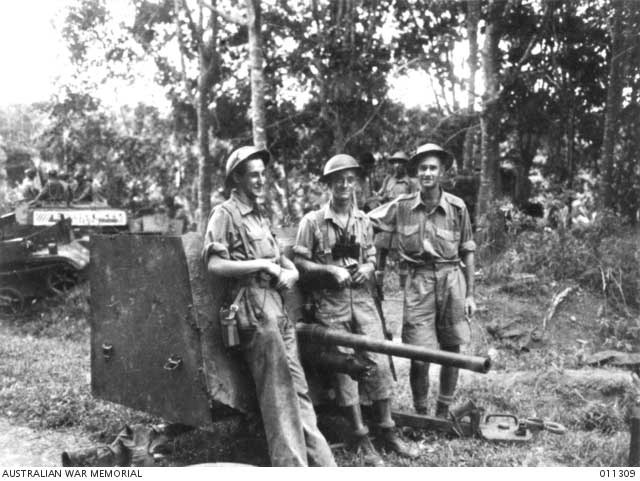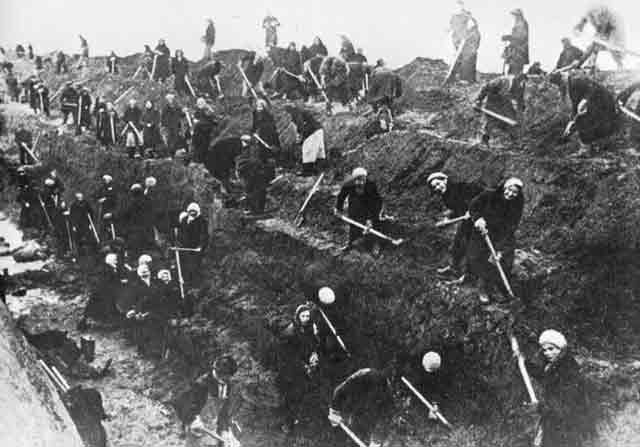Sunday 18 January 1942
 |
| "Malaya. Three Japanese Type 95 Ha-Go light tanks destroyed near Bakri by gunners from the 13th Battery, 4th Australian Anti-Tank Regiment." 18 January 1942. Australian War Memorial 011301. |
 |
| Soviet paratroopers during 1942. |
 |
| "USS Arthur Middleton (AP-55). Departing New York on 18 January 1942 en route to the Pacific after interim conversion for Naval service at the Tietjen & Lang Dry Dock Co. yard in Hoboken, N. J. She operated as a civilian-manned convoy-loaded transport until arriving at San Francisco in June 1942 for final conversion to a combat-loaded (attack) transport." Photo No. 19-N-27271. Source: U.S. National Archives, RG-19-LCM. |
 |
| "A two-pounder Anti-Tank Gun of the 4th Anti-Tank Regiment, 8th Australian Division, AIF, directed by VX38874 Sergeant (Sgt) Charles James Parsons, of Moonee Ponds, Vic, in action at a roadblock at Bakri on the Muar-Parit Sulong Road. In the background is a destroyed Japanese Type 95 Ha-Go Medium Tank. The Anti-Tank Gun was known as the rear gun because of its position in the defense layout of the area. Sgt Parsons was later awarded the Distinguished Conduct Medal (DCM) for his and his crew's part in destroying six of the nine Japanese tanks during this engagement." This appears to be another view of the ambush which resulted in the demise of the three Japanese tanks shown in the top photo on this page. Australian War Memorial 011302. |
 |
| "The crew of the forward pom-pom pause for a cigarette while at their post." Aboard minesweeper HMS Beaumaris on 18 January 1942 (© IWM (A 7207)). |
- U-66 (KrvKpt. Richard Zapp) torpedoes and sinks 6635-ton US tanker Alan Jackson east of Cape Hatteras;
- U-86 (Kptlt. Walter Schug) torpedoes 4271-ton Greek freighter Dimitrios G. Thermiotis off Newfoundland (U-86 is not actually part of Operation Drumbeat and simply sinks a member of Convoy SC-63);
- U-333 (Kptlt. Peter-Erich Cremer) torpedoes and sinks 5851-ton US freighter Caledonian Monarch of Convoy SC-63 off Newfoundland (also not a part of Operation Drumbeat, and some sources place this sinking on 22 January);
- U-552 (KrvKpt. Erich Topp) torpedoes and sinks 2609-ton US freighter Frances Salman off Newfoundland (U-552 is operating as part of Wolfpack Ziethen);
- U-123 (Kptlt. Reinhard Hardegen), having headed south from New York City, shells and then torpedoes 8206-ton US freighter Malay. The tanker makes it to Hampton Roads. Some sources place this incident on 19 January.
 |
| "Gunner and look-out on the alert for any intruders." Aboard minesweeper HMS Beaumaris on 18 January 1942 (© IWM (A 7203)). |
 |
| "A two-pounder Anti-Tank Gun of the 4th Anti-Tank Regiment, 8th Australian Division, AIF, directed by VX38874 Sergeant (Sgt) Charles James Parsons, of Moonee Ponds, Vic (center), with two crew members, identified as Gunner (Gnr) Len Coutts and Gnr Ken Daniels, standing against their Anti-Tank Gun in a clearing near the roadblock at Bakri on the Muar-Parit Sulong Road. The Anti-Tank Gun was known as the rear gun because of its position in the defense layout of the area. Sgt Parsons was later awarded the Distinguished Conduct Medal (DCM) for his and his crew's part in destroying six of the nine Japanese tanks during this engagement." 18 January 1942. Australian War Memorial 011309. |
At Muar, General Takuma Nishimura orders his 4th and 5th Guards Regiments to attack Bakri. The attack is led by nine Type 95 Ha-Gō light tanks under Captain Shiegeo Gotanda. The attack goes disastrously wrong, however, when the tanks unwisely advance without infantry support and are destroyed by Australian gunners of the 2/29th Battalion. However, the battle is not an unalloyed victory for the Australians, as the Japanese kill the commander of the battalion, Lieutenant Colonel John Robertson, while he is leading his troops during an attack along the main road. The battle is bloody, but the Australians succeed in halting the Japanese, who are forced to regroup now that they have no tanks left.
 |
| "Malayan Campaign, December 1941-January 1942. American Fighter Planes Over Malaya. American fighter planes have arrived in Malaya after month and assembly has continued at high speed but without publicity. Singaporeans have become used to the long, grey crates passing through the streets and hardly notice the roar of engine and whistle of wind past fuselage as the fighters are rested near and over the city. But the planes are here in great numbers – distributed strategically throughout Malaya. Shown are Brewster Buffalo fighters over the Malaya coasts. This photograph released circa 1942. Office War Information Photograph. Courtesy of the Library of Congress. (2016/01/22)." National Museum of the US Navy. |
Axis Relations: The main signatories of the Tripartite Pact - Italy, Japan, and Germany - sign a new military pact in Berlin. However, it is of little value given that there is little more they can do to help each other than they are doing already. In other words, the big decisions have all been made, and now it is just a question of fighting it out to victory or defeat.
British/Burmese Relations: Just like in other Asian colonies, there are pressures for independence in Burma. One of the most influential proponents of this policy is U Saw, Burma's prime minister. Saw has been in England negotiating openly with the British for promises of independence after the war and also secretly with the Japanese for promises of independence during the war. The British, through the Ultra service, learn about the latter and imprison U Saw during a stop at Haifa, Palestine.
 |
| "A big thrill, a young ATC boy has a parachute fitted and is shown how to use the safety cord in case." 18 January 1942 at the Royal Naval Air Station at Donibristle. © IWM (A 7201). |
American Homefront: New York Yankee Joe DiMaggio is named American League Player of the Year (his second of three such awards). This follows his unmatched 56-game hitting streak. Finishing second is Boston Red Sox slugger Ted Williams, who hit over .400. Neither feat has been equaled since. Both men wind up in the military during World War II.
 |
| Oliver Hardy, left, cuts the cake at this 50th birthday party on 18 January 1942 backstage at a Chicago theater while Stan Laurel looks on. As part of the act, Laurel wears a tag that says "Freight." |
1942
January 1942
January 1, 1942: Declaration By United Nations
January 2, 1941: Manila Falls to Japan
January 3, 1942: ABDA Command Announced
January 4, 1942: MacArthur on His Own in the Philippines
January 5, 1942: Soviets Plan General Offensive
January 6, 1942: US Army in Europe
January 7, 1942: Soviet General Offensive Opens
January 8, 1942: Hitler Sacks Hoepner
January 9, 1942: Battle of Dražgoše
January 10, 1942: Building the Jeep
January 11, 1942: Japan Takes Kuala Lumpur
January 12, 1941: Rommel Plans Counterattack
January 13, 1942: First Ejection Seat Use
January 14, 1942: Operation Drumbeat First Sinking
January 15, 1942: U-Boat Off NYC
January 16, 1942: Carole Lombard Crash
January 17, 1942: British Take Halfaya Pass
January 18, 1942: Soviet Paratroopers in Action
January 19, 1942: FDR Approves Atomic Bomb
January 20, 1942: The Wannsee Conference
January 21, 1942: Parit Sulong Bridge Battle
January 22, 1942: Parit Sulong Massacre
January 23, 1942: Japan Takes Rabaul
January 24, 1942: Battle of Makassar Strait
January 25, 1942: Kholm Surrounded
January 26, 1942: GIs Land in Europe
January 27, 1942: Battle of Endau
January 28, 1942: Rommel Takes Benghazi
January 29, 1942: First US Coast Guard Ship Sunk
January 30, 1942: Singapore Isolated
January 31, 1942: Army Group South Averts Disaster
2020





















